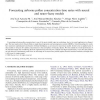Free Online Productivity Tools
i2Speak
i2Symbol
i2OCR
iTex2Img
iWeb2Print
iWeb2Shot
i2Type
iPdf2Split
iPdf2Merge
i2Bopomofo
i2Arabic
i2Style
i2Image
i2PDF
iLatex2Rtf
Sci2ools
81
Voted
ESWA
2007
2007
Forecasting airborne pollen concentration time series with neural and neuro-fuzzy models
Forecasting airborne pollen concentrations is one of the most studied topics in aerobiology, due to its crucial application to allergology. The most used tools for this problem are single lineal regressions and autoregressive models (ARIMA). Notwithstanding, few works have used more sophisticated tools based in Artificial Intelligence, as are neural or neuro-fuzzy models. In this work, we applied some of these models to forecast olive pollen concentrations in the atmosphere of Granada (Spain). We first studied the overall performance of the selected models, then considering the data segmented into intervals (low, medium and high concentration), to test how they behave on each interval. Experimental results show an advantage of the neuro-fuzzy models against classical statistical methods, although there is still room for improvement.1 Ó 2006 Elsevier Ltd. All rights reserved.
| Added | 14 Dec 2010 |
| Updated | 14 Dec 2010 |
| Type | Journal |
| Year | 2007 |
| Where | ESWA |
| Authors | José Luis Aznarte, José Manuel Benitez Sánchez, Diego Nieto Lugilde, Concepción de Linares Fernández, Consuelo Díaz de la Guardia, Francisca Alba Sánchez |
Comments (0)

